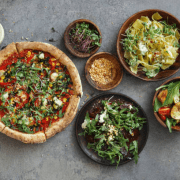The dining scene in India stands at an inflection point. With evolving consumer preferences and technological disruption, restaurants must innovate to thrive in the coming decade. This blog explores 7 future of dining set to transform the hospitality landscape of the country.
1. Experiential Dining Gaining Prominence
Elaborate themed venues, avant-garde menus, entertainment extras – the emphasis on unique experiences will intensify. Be it rainforest-themed décor orProjection mapping techniques, restaurants will go all out to wow patrons. Adventure-based attractions like indoor skydiving or arcade zones will get incorporated too. Tableside magic tricks, comedy shows, even culture walks turning the area’s history into an engaging story – such value additions promise memorable evenings.
2. Robotics & Automation Becoming Ubiquitous
Humanoid receptionists, automated dish clearing trolleys, table-serving drones – such innovations will soon become commonplace. Mundane tasks like billing or ordering will be fully automated, enabling staff to focus on customer care. Kitchen operations will see streamlining too with 3D food printers, AI menu curations, robotic stir fry stations, etc. Smart wristbands will replace wallets and menus will go hyper-personalized based on linked health data. Technology integrations thus drive efficiencies while also wowing patrons.
3. Sustainability Turning Core to Brand Ethos
As climate change concerns intensify, diners demand greener restaurant practices encompassing energy conservation, waste management, local sourcing, etc. Be it bio-dynamic farming for ingredients, renewable energy adoption, recyclable packaging, or scrap-fed urban farms – sustainability will turn integral to branding. Circular economy models like waste-to-energy conversions and water recycling systems will take prominence too. such
4. Home-Delivery & Takeaways Attaining Scale
With busy lifestyles and nuclear families, convenience is paramount. Whether pre-made gourmet meals, meal kits or curated experiences, customized delivery models will flourish. Drone food deliveries will become faster and affordable too. Takeaways will see upgrades as well with DIY meal boxes, pre-portioned entrees, and ready-to-eat comfort foods. Premium brands will leverage exclusivity while budget chains rely on economies of scale. Personalized subscriptions for curated meals likewise gain impetus.

5. Culinary Innovation Turning Cross-Cultural
Global flavors, experimental ingredients, fusion combinations – such daring experiments will hit the big leagues. Cross-pollination across Peruvian, Moroccan, Indonesian and Indian cooking traditions will yield surprising delights. Eccentric ingredients like crickets, seaweed, wild mushroom, kombucha pairings also incite curiosity. Molecular gastronomy using unconventional cooking techniques and avant-garde plating brings science into dining. Hyper-localism will simultaneously foster rediscovering lost indigenous recipes and obscure regional specialties.
6. Nutrition & Wellness Taking Spotlight
With stronger immunity and nutrition now public priorities post-pandemic, food’s health quotients will dominate choices. Both plant-forward and balanced eating will gain impetus via global wellness trends like Peganism. Adherence to safety standards will become inflexible after COVID-19 as well. QR code powered digital menus, contactless ordering via personal devices, stringent screening protocols thus drive continuity and trust. Dietary preferences likewise shape menus to accommodate paleo, gluten-free, vegan and other specialized regimes.
7. Smart Kitchens Optimizing Operations
Restaurant kitchens will turn high-tech hubs with digitized inventory monitoring, automated replenishment ordering integrated across suppliers. IoT sensors will enable remote equipment diagnostics and predictive analytics to minimize downtime. Smart storage solutions will track expiry and rotation of perishable stocks too. Robotics takes charge of dangerous, repetitive tasks. While Cloud based data insights identify customer preferences and sales patterns. Staff shift scheduling apps too boost productivity in the backend.
The Way Forward
India’s food services market is on an exponential growth trajectory, estimated to touch ₹58,97,591 crores by 2027-28. Riding along such fast-paced evolution calls for agile strategies, tech-savvy innovation and passion for great hospitality from eating establishments. The 7 future of dining trends above signal how restaurants must prepare for the future by merging convenience, experiences, health, and sustainability into their core proposition. Digital transformation thereby forms fundamental to competing in tomorrow’s landscape. The time is now ripe for restaurants to digitize, streamline operations using smart kitchens and deliver exceptional customer experiences every single time.
Also read- Start a sustainable diet with Healthy North Indian cooking
















